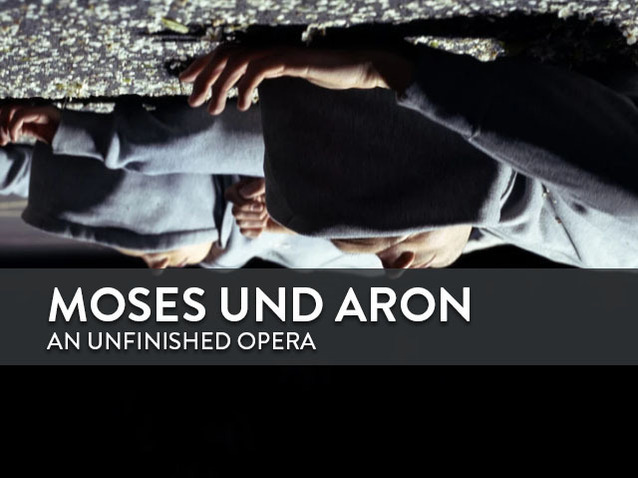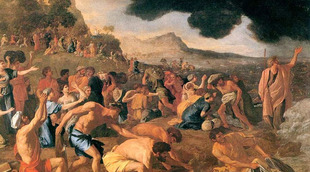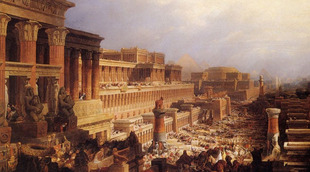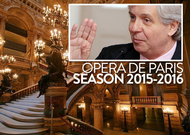 © DR
© DR
Next saturday, Moses and Aaron is played at the Opéra de Paris, in a new production signed by Romeo Castellucci (which will be broadcasted online next week). A choice taken by Stéphane Lissner for his first season at the very head of the parisian house, who wants to « interrogate about the greater questions on the world we are living in ». We take this occasion to analyse the issues (mostly lyrical) of this rare opera, sometimes diffcult to access.
***
Moses und Aron, an unfinished opera, is the last and most imposing lyric work composed by Arnold Schoenberg (1874-1951), aside from his huge dramatic oratorio Gurre-Lieder (1900-1911).This biblical drama, for which the musician himself wrote the libretto based on passages from the Pentateuch, holds a special place in the history of music.Moses und Aron remains Schoenberg’s most complex and formally audacious work, to the point that the musician himself feared it would never be performed because of the many difficulties involved in staging and performing it.This is a “dodecaphonic” opera that seeks to provide a response to new challenges.Once the classical tonal language has been called into question, how can one give musical and dramatic consistency to a lyrical work of great scale? Riddled with these questions and these formal trials, Moses und Aron also became known for its insistence on questioning existence itself.Two Biblical characters, Moses and his brother Aaron, symbolize the opposition between Thought and Action in a period dominated by political upheaval that ended in Nazi barbarism.
In search of opera
A founder and instructor of the “Vienna School”, Arnold Schoenberg (1874- 1951) was responsible for a profound change in music history.He shattered conceptions of classical music by developing “dodecaphonism” and “serialism”, i.e., use of the technique of “composing with only twelve sounds connected to one another”. Alban Berg (1885-1935) and Anton Webern (1883-1945) were his best-known pupils.

The first of his works based entirely on the new musical language he developed was the Suite for piano op. 25 (1921).In 1918 he founded the “Society for Private Musical Performances” in Vienna, to keep out any critic or criticism, as no one was allowed to make any value judgment!It should be noted that, by and large, critics could not find sufficiently harsh words to denounce and belittle a form of music that seemed to them just barely listenable. Schoenberg’s creative evolution was not even remotely understood by his contemporaries.He considered himself “a conservative forced to turn radical”.In 1925 he was appointed professor at the Prussian Academy of Arts in Berlin, where he remained until 1933. It was there that he began the long and difficult process of composing Moses und Aron, a work that cost him so much effort and caused him such torment that it was never finished.
Before Moses und Aron, which looks like a summary, two works appeared as attempts to revive the lyric tradition, Erwartung (Expectation) (1909) and The Hand of Fate (1908-1913). In these two dramas, both of them only about twenty-five minutes long, unity is assured only by the libretto, as the abandonment of tonality carries with it the loss of the usual points of reference in the lyrical genre. This raises the question of how one can give musical and dramatic consistency to a work that unfolds in one continuous movement with no tonal foundation.In 1928, Alban Berg wrote an article entitled “Opera’s Problem”. The twenty years during which Schoenberg continued to compose Moses und Aron without ever managing to finish it can be explained by the issues raised by the conception of an opera in a new genre, based entirely on a dodecaphonic series. In Moses und Aron, all of the musical material derives from a series of twelve tones, the tones of the scale, which is first introduced in Aaron’s speech: “Oh, sons of my fathers”, subsequently undergoing multiple combinations and variations according to the system conceived by the composer himself.
In early 1930, Schoenberg began thinking about a large-scale opera.The first sketch dates from 7 May 1930, and by June the composer had devoted himself entirely to his new project, working at a feverish pace.He had two jobs, it might be said: he was writing the score and the libretto simultaneously.This aspect needs to be underscored, as it is quite unusual for a musician to work on his libretto at the same time as he is composing the music.As he himself stressed, this assumes that you have: “… a very precise idea, and the trick consists not just of always keeping this vision alive, but even more of strengthening it, enhancing it and expanding it as you create the details”.In a letter sent to Anton Webern in September 1931, Arnold Schoenberg spells out the problems he encountered and the care he applied to writing the libretto:“Given my experience, I do not dare estimate the proportions of the third act which, at the moment, I do not believe will exceed twenty minutes (…).What wastes a great deal of time is writing the text (…).The precise creation of the “Dance around the Golden Calf” scene required a great deal of work.I wanted to leave as few things as possible to the new masters of the theatre arts, the directors, and I also wanted to create and plan the choreography to the greatest extent possible (...)”. The first two acts were completed on 18 March 1932 in Barcelona; the final text of the third act did not appear until May1935, in the United States.Schoenberg kept trying to compose the music for this final act until his death on 13 July 1951.

Whilst several theories can be advanced to account for this creative paralysis, one immediate explanation might be the sudden change in lifestyle which political events forced on the musician.The persecution of the Jews that came with the rise of Nazism affected Schoenberg, even though he had converted to Protestantism in 1898.In 1933 the musician was dismissed from his professorship at the Berlin Academy of Music because of his Jewish roots.He fled to Paris where, out of solidarity with the people he had never felt part of, he converted back to Judaism.“I finally learned the lesson that was beaten into me last year, and I will never forget it:I am not a German or a European, perhaps not even a human being, but I am a Jew.”He then moved to the United States where he lived in exile until his death, experiencing difficult financial conditions despite working as a teacher. Schoenberg had begun this return to his roots in 1917 with the oratorio, Jacob’s Ladder, which remained unfinished, and with the drama entitled Biblical Road (1922-1923) in which we find a forerunner of the two brothers in Moses und Aron.In 1928 he set about composing a cantata entitled “Moses before the Burning Bush”, which gradually turned into a three-part oratorio bearing the title of his future opera, Moses und Aron.
Schoenberg was persuaded that his opera was too much ahead of its time.The composer even doubted that his work would be performed “in the next few decades”.Schoenberg added new instruments to the classical orchestra, some of them rare ones like the celesta or the flexatone, a metal percussion instrument.Even aside from the two main characters, the treatment of the voice is rich and inventive.The voice of God echoing around the edges of the work is realized by a choir of six soloists, and a spoken chorus. There is a plethora of secondary roles, some of them making a very brief appearance.As in grand opera, the choral parts are among the most imposing. The chorus, which by turns sings and speaks, also serves most often as a key figure.He is the Chosen People, always undecided in regard to Moses and Aaron.The climax of the chorus’s involvement comes in the Golden Calf scene, in which fury and savagery are truly unleashed. The people then become agitated and violent as Aaron himself seems overcome by doubt.To avoid the seething rebellion, Aaron re-establishes the ancient idol cult, which is besieged by worshipers. Orgiastic scenes accompany this step backward, far from the idea of an eternal, invisible god.
In 1949 Schoenberg went so far as to admit that he had not written his opera to be staged, “except perhaps in the distant future, with a sound produced synthetically, electrically”.A partial staging took place whilst the composer was still alive, when “Dance around the Golden Calf” was performed in Darmstadt in 1951. This staging was then planned as part of Florence’s Musical May in 1951.Schoenberg then suggested completing the two existing acts with a spoken performance of the third act, for which only the text existed.This solution was seldom adopted after that, and tradition has it that only the first two acts are played complete; fortunately, the two acts form a perfectly viable unit.It was not until 1954 that Moses und Aron was finally performed in concert version in Hamburg.The staged version was not created until 1957 in Zurich.Through the 1960s there were very few revivals of the work, which did not begin to appear frequently on the greatest stages until 1970.
Omnipresent, invisible and unimaginable
“…the sole, eternal, omnipresent, invisible and unimaginable God….”: Thus begins the work written by Schoenberg, who had been reading the Bible since he was a small child.This early indoctrination undoubtedly justifies a very personal interpretation of the Bible’s texts, as shown by the use and examination of various famous episodes such as the feats performed by Moses, attributed by the composer to Aaron, or the Golden Calf episode. This very unique plot line is the basis for a philosophical reflection on the respective powers of thought and action, two entities incarnated by two characters, Moses and Aaron.By throwing them together, Schoenberg seems to be guided by Rilke’s verses, which he first put to music in 1914 in the second of his Four Lieder with orchestra op.22: “All those who seek Thee afflict Thee.And those who find Thee bind Thee to an image or a face.But I want to understand Thee.”
Formally speaking, it can be said that the dodecaphonic series on which the work is based is comparable to that “..sole, eternal, omnipresent, invisible and unimaginable God….”that is at the heart of Moses’ concerns and questions as he is overwhelmed by the task God has entrusted to him, to free the Jewish people from Egypt. The unique, omnipresent and sometimes invisible principle of the series contrasts with the duality of the protagonists, Moses, bearer of God’s Thought, and Aaron, his brother, bearer of God’s Word. Moses feels incapable of convincing his divided flock, who are still bound to the old gods. And the Eternal One replies: “Aaron shall be thy mouth”.The two brothers then face one another.Moses struggles to find the right words to share his demanding conception of God.The glib Aaron seduces and inveigles, establishing his supremacy over Moses.Moses, rendered mute, expresses himself only through “Sprechgesang”, a rhythmic recitation that contrasts with the ease of Aaron’s brilliant singing, a dramatic lyric role that holds the Chosen People under the spell of his voice.
Use of the Sprechgesang technique alongside proper singing had already been perfected by Schoenberg in a work that had a huge impact, the Pierrot lunaire, a cycle of 21 melodramas for spoken voice and five instruments created in 1912. Schoenberg defined Sprechgesangas follows:“Spoken singing is not singing plus some speaking, it’s neither singing nor speaking”.The simultaneous use of singing and speaking was the work’s most significant innovation from a dramatic standpoint.This unusual alliance gives unusual expressive power to the confrontation between two brothers, and to the choral elements, as the choristers also switch between singing and “recitation”. Hence the “Voice from the Bush” in Act 1 takes on a fantastical dimension because of the duality of the choir divided into two parts, with one singing while the other speaks while “enunciating very distinctly”.Moses expresses himself through Sprechgesangwith only one exception, (Act 1, scene 2) and he addresses to Aaron this single sung sentence, consisting of six measures:“Purify thy thought, flee futility, devote yourself to the Truth”. Having run out of arguments, Moses tries to use the magic of song to convince his brother who betrayed him by misrepresenting his thought which he was responsible for transmitting to the people.
At the end of the second act, Moses tries to find the words he needs to convince and convey his very demanding conception of God.After a final confrontation with Aaron, he realises his brother will never achieve the goal he has set for him:“Purify thy thought, flee futility, devote yourself to the Truth”.Tortured by his strong sense of powerlessness, Moses falls to the ground, ending his poignant monologue with these final words, which are a perfectly viable ending for an opera left unfinished: “O words, you words I miss so!”.This final cry rings out like that of the composer himself, who lacked the inspiration to complete his work.Schoenberg may have said everything he had to say about his very personal vision in one key scene in his opera, that of the Dance around the Golden Calf, unleashing all the resources of the lyric art, orchestra and soloists, choruses and dances, to convey all the madness, violence and self-destruction that can overtake helpless humanity.As he tells us himself:“The Golden Calf scene represents a sacrifice of the people trying to rid themselves of a ‘soulless’ belief. In developing this scene, since it represents the core of my thinking, I went very far, and that is where my opera is the most operatic; it could not be otherwise”.
Catherine Duault
the 14 of October, 2015 | Print

Comments